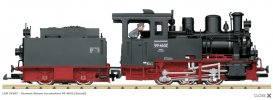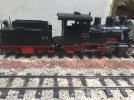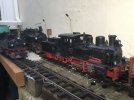idlemarvel
Neither idle nor a marvel
Received this yesterday as a present to myself during lockdown 
I used to have a blue version of this loco LGB 20261. This is the latest incarnation from Maerklin with mfx decoder, sound, pulsed smoke generator synchronised to the wheels, reed switches, and a motor in the loco and in the tender. The only thing missing is firebox glow.

First thing I noticed out of the box was how many wires there are to connect the loco with the tender. Two plugs, one black 4-wire, presumably for motor and track + and -, and one red 10-wire, for everything else. Regulars may remember a discussion a few years ago about how many decoders and where to put them in a loco like this, and how many wires you would need between the loco and the tender. See here if you are interested: Digitising LGB 20261 Nicki-Frank-S steam tender loco - G Scale Central

Maerklin have gone for one decoder in the tender, which is also where the speaker is located, the track reed switches, the "four way switch" and the volume control, and everything in the loco controlled by wires from the tender. I know the decoder is in the tender because if you disconnect them, the tender moves but the loco stays still! As has been discussed before the tender moves slightly more quickly than the loco, but not enough to make any real difference to running.
The tender contains the LGB 4-way switch and a volume control, under the water tank covers. You need a small screwdriver to adjust the volume unless you have very small nimble fingers.

If you don't have an mfx controller you need to switch to DCC mode by setting CV50 to 0, or 2 if you might want to use this on DC/analog at some point. If you do get into changing the configuration, note that the front top headlight is attached to AUX1 separate from the other two front headlights. AUX3 is the cab light.
Gripes
This is my main complaint. Compared to my old blue one, the fold down footplate between the loco and the tender won't go flat as it is too long for the gap, and if you have it half down it catches going round bends. You could trim it to fit and I might do that but it is disappointing in a brand new loco. Do other owners of this loco have this problem?

Plugging the 4 wire plug in is easy, but the 10 red wire plug is very challenging as there is not much play or space between the units and you can't see what you are plugging it into. It's easy to test if it is in place as the loco lights don't work if it isn't seated properly. I may be wrong but I'm not sure those cables are going to stand the test of time?
Cosmetically, they still insist on having the metal boiler bands. They are not shiny brass like older models, more subdued, but they still seem a garish to me and I haven't seen any pictures of 99 4652 which show such bands, for example:

At least they now have black lamp surrounds. They carefully paint all the electrical boxes on the tender yellow but not the ones on the loco. Easily remedied but why?
Goodies
The sound is very crisp and clear if rather strange at first coming from the tender. You only notice this if you're close up. Out of the box some of the additional sounds like station announcement and coal shovelling are very loud compared to the engine noises, but these can be adjusted with CV settings. You get all the usual stuff, whistle (long and short), bell, coal shovelling, injector, air pump, brakes, etc. While running you get louder chuffs starting, and moments of idling when slowing down.
The pulsed smoke generator is excellent, lots of smoke when standing, large plumes when starting, puffs synchronised to the wheels and chuff sound. It does burn through the smoke fluid quite quickly but it is the most impressive smoke generator I've seen in a ready to run loco.
You can use track magnets to sound the whistle or bell which is handy if you use analog or DCC. They provide two track magnets.
BTW if you do run analog, the lights, sound and smoke are turned on for you.
Putting the 4-way switch and volume controls out of sight under covers is a good idea. Having them inside cabs has always struck me as a bad idea, cosmetically (looks naff) and practically (can't get your fingers inside the cab easily), although better than under the loco.
Overall
It is quite an accurate model of the prototype. The scale is more like 1:19.5 but that is the LGB rubber ruler for you. With 10 powered wheels and 14 pickups there is no problem with electrical connections on any track configuration or speed. It runs very well and I imagine it could pull quite a load. Very pleased and apart from the folding footplate issue highly recommended. It is quite pricy but for a loco 0.5m long with 2 motors, DCC sound card and pulsed synchronised smoke generator all fitted it's not too bad.
I used to have a blue version of this loco LGB 20261. This is the latest incarnation from Maerklin with mfx decoder, sound, pulsed smoke generator synchronised to the wheels, reed switches, and a motor in the loco and in the tender. The only thing missing is firebox glow.

First thing I noticed out of the box was how many wires there are to connect the loco with the tender. Two plugs, one black 4-wire, presumably for motor and track + and -, and one red 10-wire, for everything else. Regulars may remember a discussion a few years ago about how many decoders and where to put them in a loco like this, and how many wires you would need between the loco and the tender. See here if you are interested: Digitising LGB 20261 Nicki-Frank-S steam tender loco - G Scale Central

Maerklin have gone for one decoder in the tender, which is also where the speaker is located, the track reed switches, the "four way switch" and the volume control, and everything in the loco controlled by wires from the tender. I know the decoder is in the tender because if you disconnect them, the tender moves but the loco stays still! As has been discussed before the tender moves slightly more quickly than the loco, but not enough to make any real difference to running.
The tender contains the LGB 4-way switch and a volume control, under the water tank covers. You need a small screwdriver to adjust the volume unless you have very small nimble fingers.

If you don't have an mfx controller you need to switch to DCC mode by setting CV50 to 0, or 2 if you might want to use this on DC/analog at some point. If you do get into changing the configuration, note that the front top headlight is attached to AUX1 separate from the other two front headlights. AUX3 is the cab light.
Gripes
This is my main complaint. Compared to my old blue one, the fold down footplate between the loco and the tender won't go flat as it is too long for the gap, and if you have it half down it catches going round bends. You could trim it to fit and I might do that but it is disappointing in a brand new loco. Do other owners of this loco have this problem?

Plugging the 4 wire plug in is easy, but the 10 red wire plug is very challenging as there is not much play or space between the units and you can't see what you are plugging it into. It's easy to test if it is in place as the loco lights don't work if it isn't seated properly. I may be wrong but I'm not sure those cables are going to stand the test of time?
Cosmetically, they still insist on having the metal boiler bands. They are not shiny brass like older models, more subdued, but they still seem a garish to me and I haven't seen any pictures of 99 4652 which show such bands, for example:

At least they now have black lamp surrounds. They carefully paint all the electrical boxes on the tender yellow but not the ones on the loco. Easily remedied but why?
Goodies
The sound is very crisp and clear if rather strange at first coming from the tender. You only notice this if you're close up. Out of the box some of the additional sounds like station announcement and coal shovelling are very loud compared to the engine noises, but these can be adjusted with CV settings. You get all the usual stuff, whistle (long and short), bell, coal shovelling, injector, air pump, brakes, etc. While running you get louder chuffs starting, and moments of idling when slowing down.
The pulsed smoke generator is excellent, lots of smoke when standing, large plumes when starting, puffs synchronised to the wheels and chuff sound. It does burn through the smoke fluid quite quickly but it is the most impressive smoke generator I've seen in a ready to run loco.
You can use track magnets to sound the whistle or bell which is handy if you use analog or DCC. They provide two track magnets.
BTW if you do run analog, the lights, sound and smoke are turned on for you.
Putting the 4-way switch and volume controls out of sight under covers is a good idea. Having them inside cabs has always struck me as a bad idea, cosmetically (looks naff) and practically (can't get your fingers inside the cab easily), although better than under the loco.
Overall
It is quite an accurate model of the prototype. The scale is more like 1:19.5 but that is the LGB rubber ruler for you. With 10 powered wheels and 14 pickups there is no problem with electrical connections on any track configuration or speed. It runs very well and I imagine it could pull quite a load. Very pleased and apart from the folding footplate issue highly recommended. It is quite pricy but for a loco 0.5m long with 2 motors, DCC sound card and pulsed synchronised smoke generator all fitted it's not too bad.



